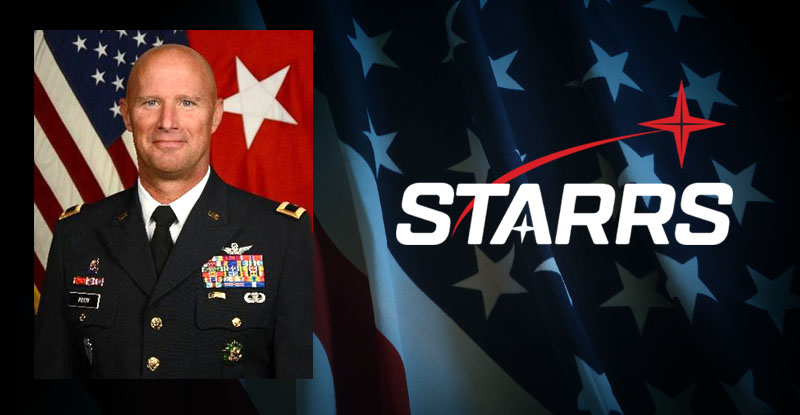General Christopher Petty graduated from the United States Military Academy at West Point in 1987. During his 31 years in uniform, he commanded troops at the company, battalion, brigade, and joint/multi-national levels for over 11 years.
He commanded an aviation battalion (the 2-135th Aviation) during the “Surge” in Iraq, where the unit distinguished itself by performing a record-setting 100 large-scale, nighttime, air-assault operations in support of the Theater Special Operations Task Force.
Despite numerous enemy engagements, aircraft shoot downs, and losses to enemy mortar fire, he brought everyone home. This exemplary service would earn the unit the Meritorious Unit Citation, along with the national level “Outstanding National Guard Aviation Unit of the Year Award” presented by the Chief of Staff of the Army.
His general-officer assignments included command of the NATO Headquarters in Bosnia, Special Assistant to the Director of the Army National Guard, and Deputy Director of Operations for Headquarters Department of the Army (DA G-3/5/7) in the Pentagon, where he personally briefed the Secretary of the Army and members of the House Armed Service Committee on various operational and readiness issues.
In his final assignment, he served as the Deputy Director of Operations for United States Northern Command (USNORTHCOM) where he managed Ballistic Missile Defense, Information Operations, Intelligence and Reconnaissance Operations, and various contingency operations for the command.
General Petty holds Masters degrees from both the US Army War College and Colorado State University.
He is a graduate of the National Defense University’s Joint and Combined Warfighting School and the Chairman’s Capstone and Advanced General Officer Education Programs.
He has completed senior-executive training at both Harvard’s Kennedy School and Wharton, and is a National Security Fellow at Syracuse University.
General Petty has lectured at the Army War College’s Center for Strategic Leadership, the United States Coast Guard Academy, and various national-level forums and conferences.
General Petty is an airborne, ranger, instructor pilot, master aviator. His awards include the Defense Superior Service Medal, Legion of Merit, Meritorious Service Medal, the Bronze Star, and the Air Medal. He has flown over 2600 hours in Army helicopters, 356 of which were in combat.
Upon retirement he founded Battle Digest; a military history publication using battles as case studies to understand the timeless lessons of leadership and war.
He and his wife, Beth, have four sons and seven grandchildren and live in Parker Colorado.
Battle Digest
Executive summaries of history’s important battles — including lessons on strategy, tactics and leadership — all in an easy-to-read tri-fold brochure.
12 Battles Every American Should Know: Lessons Learned from Lexington to Desert Storm by BG Chris Petty, US Army ret
 Book description: This book is a journey through twelve epic battles of American history. And because battles determine wars, and wars determine history, it is a journey worth taking.
Book description: This book is a journey through twelve epic battles of American history. And because battles determine wars, and wars determine history, it is a journey worth taking.
Through these twelve battles, you will gain insights into some of the most important leaders, ideas, and conflicts that have defined this country. Some battles, like Lexington and Pearl Harbor, represent beginnings of great American struggles.
Others, like Yorktown, Shiloh, Gettysburg, Midway, D-Day, and Desert Storm represent critical turning points, or culminations of, America’s wars. While the rest, Bunker Hill, Little Bighorn, the Alamo, and Antietam stand out as famous landmarks along our journey towards a common cultural heritage. These twelve battles are famous for a reason: They are part of our shared history. They bind us as a nation.
This book will appeal to many. Students will appreciate the easy-to-understand format, especially compared with modern American history textbooks. Parents and teachers will find it a great companion resource to support learning.
Historians, if they can temporarily suspend their hunger for excruciating detail, will be impressed by the brevity. Members of the military will profit from these pages as they find a guidebook into the underlying patterns and structure of warfare amidst a trove of timeless lessons.
The value comes not just from content, but also from a standardize format. The deliberate brevity renders these battles readable and comprehensible, while the format conveys the essence of the struggles.
This unique combination captures a truism of war, that all battles operate within a strategic context, in which leaders develop an operational framework to create a desired end state. This framework is then altered by events and decisions that require adjustment to deliver victory.
In the end, the river of history adjusts course, leaving timeless lessons deposited on the riverbank. It is in these lessons where the continuities and causal relationships are found. This format captures them, allowing the patterns of warfare and history to better emerge from the pages. And in a special nod to the military, the discussion questions will prove invaluable for facilitating thought-provoking group conversations and classes to assist in understanding the continuities, causations, and correlations in warfare.
War is an inexorable part of the human condition ‒ with us since mankind first formed into tribes. It flows through the ages ‒ from empires, through kingdoms, and into the age of the nation-state. It will be with us forever. As such, it must be understood. And by understanding battles, we can better understand war. Battles are the decisive points ‒ the turning points ‒ that define victory or defeat. American ideas have, and will be, won and lost on the fields of battle.

